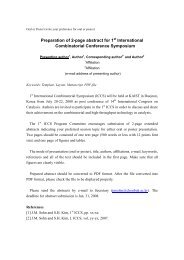Bidding - the International Association of the Catalysis Societies
Bidding - the International Association of the Catalysis Societies
Bidding - the International Association of the Catalysis Societies
Create successful ePaper yourself
Turn your PDF publications into a flip-book with our unique Google optimized e-Paper software.
characterization <strong>of</strong> zeolite and new microporous materials such as KIT-1 and carbon<br />
molecular sieves, catalysis for C 1 chemistry, syn<strong>the</strong>sis <strong>of</strong> specialty polymers using<br />
Ziegler-Natta or metallocene catalysts, hydrotreating catalysts for HDS, HDN, HDW or<br />
HDM, and deNO x catalysts.<br />
5. Center for Ultramicrochemical Process Systems (CUPS), KAIST, Daejeon<br />
CUPS was established in 2001 by <strong>the</strong> Ministry <strong>of</strong> Science & Technology as an excellent<br />
national center intended for <strong>the</strong> next-generation science and technology and located at<br />
KAIST (Korea Advanced Institute <strong>of</strong> Science & Technology). Twenty researchers are<br />
carrying out research on <strong>the</strong> fabrication <strong>of</strong> microchemical and <strong>the</strong>ir applications. Special<br />
emphases are put on <strong>the</strong> high-throughput-screening for <strong>the</strong> novel catalysts for<br />
environments and energy conversion. Parallel syn<strong>the</strong>ses <strong>of</strong> catalyst library and <strong>the</strong> fast<br />
screening <strong>of</strong> <strong>the</strong>ir catalytic properties are being developed. High speed<br />
characterization methods <strong>of</strong> catalysts such as TPD, Raman, UV/Visible, Fluorescence<br />
and chemisorption measurement are developed. Data mining and informatics for <strong>the</strong><br />
best design <strong>of</strong> library are also pursued. The aim <strong>of</strong> CUPS is establishing <strong>the</strong> methods for<br />
<strong>the</strong> high-throughput-screening <strong>of</strong> novel functional materials and creating new catalytic<br />
processes and portable microchemical processes.<br />
6. The Korea Institute <strong>of</strong> Science and Technology (KIST), Seoul<br />
KIST is <strong>the</strong> Government-established institute carrying out research to bridge<br />
universities and local industries. In 1970s, it successfully commercialized catalytic<br />
processes for <strong>the</strong> syn<strong>the</strong>sis <strong>of</strong> malonic esters and CFC’s based on self-developed<br />
technology. Twelve principal investigators at <strong>the</strong> Ph.D. level and about 20 researchers at<br />
<strong>the</strong> M.S. level are working in areas including <strong>the</strong> preparation <strong>of</strong> aerogel-type materials<br />
by <strong>the</strong> sol-gel process, C 1 chemistry, catalytic wet oxidation for waste-water treatment,<br />
desulfurization and deodorization <strong>of</strong> exhaust gases, and syn<strong>the</strong>sis <strong>of</strong> CFC alternatives.<br />
This group is particularly strong in process development through pilot-plant tests.<br />
7. The Korea Research Institute <strong>of</strong> Chemical Technology (KRICT), Daejeon<br />
In this Government-established institute aimed at applied research to support <strong>the</strong> local<br />
chemical industry, thirty researchers (15 Ph.D.s) are working in all areas <strong>of</strong> catalytic<br />
technology. Recent developments by KRICT include <strong>the</strong> process for polybutene<br />
syn<strong>the</strong>sis from C 4 feedstocks (110,000 Ton/yr), ammoxidation catalysts for pyrazine<br />
amide and acrylonitrile, catalysts for aromatic alkylation, CO 2 activation via Fischer-<br />
Tropsch route, and zeolite-type detergent builder. KRICT is equipped with modern<br />
instruments for catalyst characterization.<br />
8. The Korea Institute <strong>of</strong> Energy Research (KIER), Daejeon<br />
KIER is <strong>the</strong> Government-established institute for research on <strong>the</strong> efficient utilization <strong>of</strong><br />
energy from fossil and non-fossil fuel, and <strong>the</strong> exploitation <strong>of</strong> renewable energy. Twenty<br />
five researchers (20 Ph.D.s) are working on photocatalysis, fabrication <strong>of</strong> industrial<br />
catalysts and adsorbents, utilization <strong>of</strong> natural gas, catalytic combustion, and catalytic<br />
abatement <strong>of</strong> hazardous gases.<br />
- 64 -



